| Columns Retired Columns & Blogs |
Denon PMA-1600NE ($1,599) integrated amp would be a good comparison :-) .........
I measured the Exposure XM5 integrated amplifier and D/A processor with my Audio Precision SYS2722 system (see the January 2008 "As We See It"). Usually before performing any testing, I run an amplifier for an hour at one-third power into 8 ohms, which is thermally the most stressful condition for a design with a class-AB output stage. With the Exposure XM5, however, I cut short this preconditioning after 15 minutes. The temperature of the amplifier's bottom panel, to which the output devices are fastened, had already reached 163.6°F (73.1°C), and I was concerned that the XM5 would go into thermal runaway. The top panel was also hot, at 105.1°F (40.6°C). Clearly, this little amplifier doesn't have enough heatsink capacity for sustained operation at highish powers. The owner should ensure that it's well ventilated.
Looking first at the line-level analog inputs: With the volume control at its maximum setting, the voltage gain at 1kHz into 8 ohms measured 36dB from the speaker terminals, 12.06dB from the preamplifier outputs. The line inputs preserved absolute polarity (ie, were non-inverting) from both outputs. The input impedance was 14.7k ohms at low and middle frequencies, dropping slightly to 12.4k ohms at 20kHz. The preamplifier output had an appropriately low output impedance of 68 ohms at 1kHz and 20kHz, but this rose to 430 ohms at the bottom of the audioband.
The output impedance at the speaker terminals (including cables) was a low 0.09 ohm at 20Hz and 1kHz, rising to 0.55 ohm at 20kHz. As a result, the modulation of the Exposure's frequency response with our standard simulated loudspeaker was just ±0.05dB (fig.1, gray trace). The amplifier's output is down by 0.5dB at 20kHz and rolls off above 30kHz, which lengthens the risetimes of a 10kHz squarewave (fig.2). However, there is no overshoot or ringing. Note the excellent channel matching in fig.1, taken with the volume control set to its maximum. Commendably, the matching was preserved at lower settings of the control, as was the frequency response.
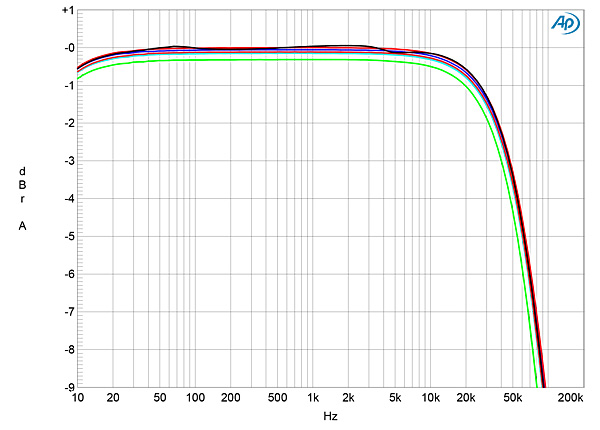
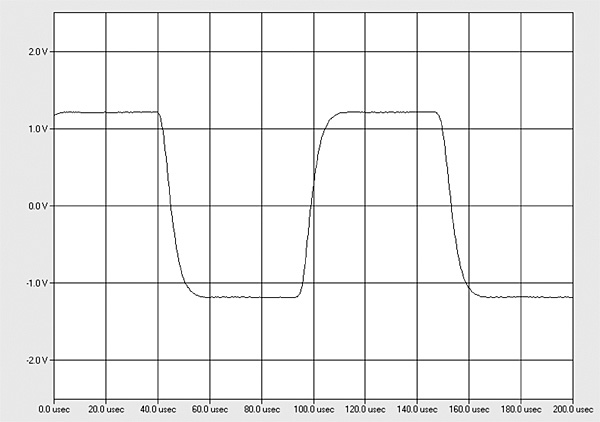
The XM5's channel separation was modest, at 63dB in both directions from 100Hz to 20kHz. With the line inputs shorted to ground and the volume control set to its maximum, the wideband, unweighted signal/noise ratio (ref. 2.83V into 8 ohms) measured 80.7dB (average of both channels). Restricting the measurement bandwidth to 22kHz increased the ratio to 83.1dB in the left channel, 87.8dB in the right, and an A-weighting filter increased both ratios by another 4dB. Fig.3 shows the low-frequency spectrum of the XM5's output while it drove a 1kHz tone at 1W into 8 ohms. The highest-level spuriae are at the AC power-line frequency of 60Hz and its odd-order harmonics, presumably due to magnetic coupling from the power transformer. In so small an enclosure, the low-level circuitry can't be kept far enough away for this not to occur.

Exposure specifies the XM5 as delivering a maximum power of 60Wpc into 8 ohms (17.8dBW). At our usual definition of clipping (ie, when the percentage of THD+noise in the amplifier's output reaches 1%), with continuous drive in both channels, the XM5 exceeded that spec, delivering 70Wpc into 8 ohms (fig.4, 18.45dBW). With both channels driven into 4 ohms, the amplifier clipped at 106W (fig.5, 17.2dBW). I didn't test the clipping power into 2 ohms, as I was concerned the amplifier would overheat.
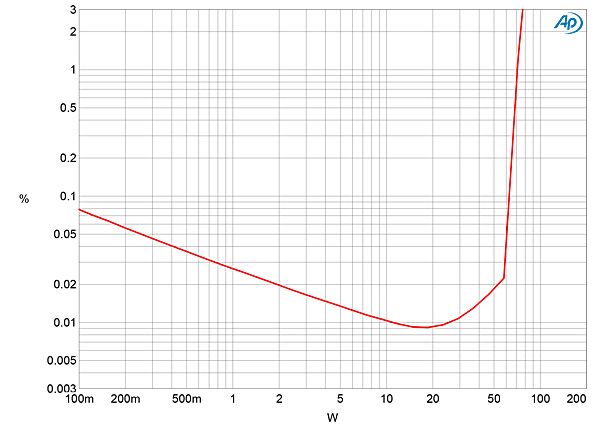
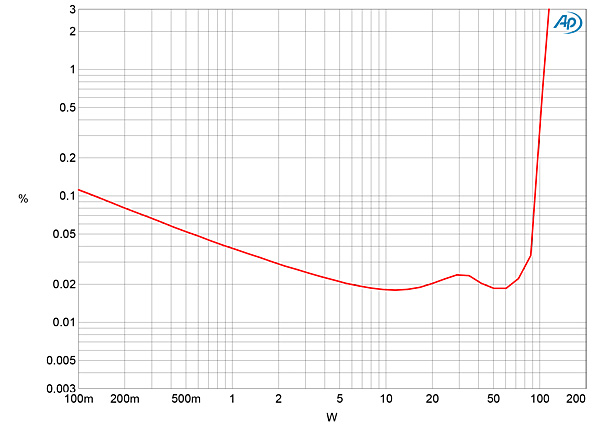
I looked at how the XM5's THD+N percentage varied with frequency at a level of 6.93V, which is equivalent to 6W into 8 ohms, 12W into 4 ohms, and 24W into 2 ohms. The distortion levels were very low in the bass and midrange in both channels into 8 ohms (fig.6, blue and red traces), though with the usual rise at higher frequencies due to the circuit's decreasing open-loop bandwidth. However, while the right channel performed almost as well into 4 ohms (magenta trace), the left channel offered higher distortion (cyan trace), and even greater levels into 2 ohms (gray). The shape of the distortion-spuriae waveform in the right channel (fig.7) suggests that the second harmonic was the highest in level, but with higher-order harmonics present. Spectral analysis indicated that this was the case into 8 ohms (not shown) and 4 ohms (fig.8, red trace), but that the third and fifth harmonics were the highest in level in the left channel (blue). Both second-order and higher-order intermodulation products at 20Wpc into 8 ohms were very low in level (fig.9), perhaps due to the amplifier's restricted ultrasonic bandwidth.
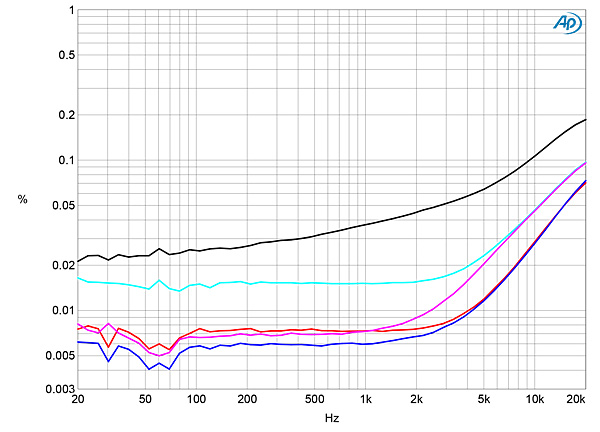
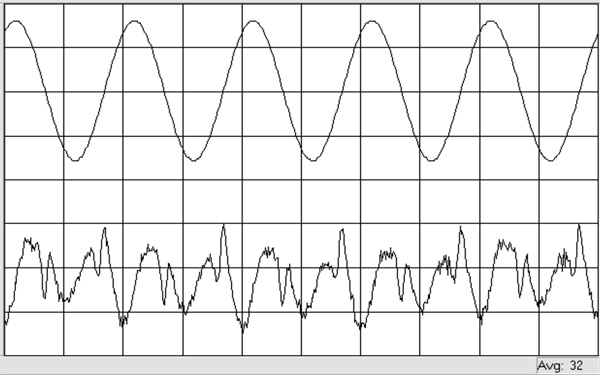

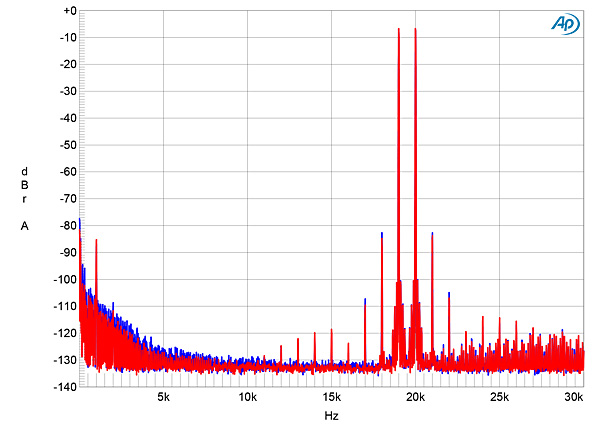
Turning to the XM5's digital inputs, the optical S/PDIF input locked to datastreams with sample rates up to 96kHz, the coaxial inputs up to 192kHz. All digital inputs preserved absolute polarity. Apple's USB Prober utility identified the XM5 as "xCORE-AUDIO Hi-Res 2" from "XMOS," and confirmed that its USB port operated in the optimal isochronous asynchronous mode. The AudioMIDI utility revealed that the USB port could handle 16- and 24-bit integer data at all sample rates up to 192kHz. With the volume control set to its maximum, a 1kHz digital signal at –12dBFS resulted in output levels of 1.28V at the preamp outputs and 20.1V into 8 ohms at the speaker outputs. The latter is equivalent to 50W into 8 ohms, which is 1.4dB below the measured clipping power into this load. As is often the case with integrated amplifiers offering digital inputs, these have around 10dB too much gain compared with the line-level analog inputs. I continued testing the Exposure's digital inputs from the preamplifier outputs with the volume control set to 12 o'clock.
The XM5's impulse response with 44.1kHz data (fig.10) indicates that its reconstruction filter is a conventional linear-phase type, with symmetrical ringing on either side of the single sample at 0dBFS. With 44.1kHz-sampled white noise (fig.11, red and magenta traces), the response rolled off above the audioband, reaching full stop-band suppression at 24kHz. The aliased image at 25kHz of a full-scale tone at 19.1kHz (blue and cyan traces) is suppressed by 83dB, though harmonics of this tone can be seen, with the second the highest in frequency at –57dB (0.014%). The Exposure's digital frequency response with data sampled at 44.1, 96, and 192kHz follows the same basic shape at each sample rate, with a sharp rolloff with 44.1kHz data (fig.12, green and gray traces). The response at the two higher sample rates rolls off earlier than expected, presumably due to the amplifier's limited ultrasonic bandwidth.
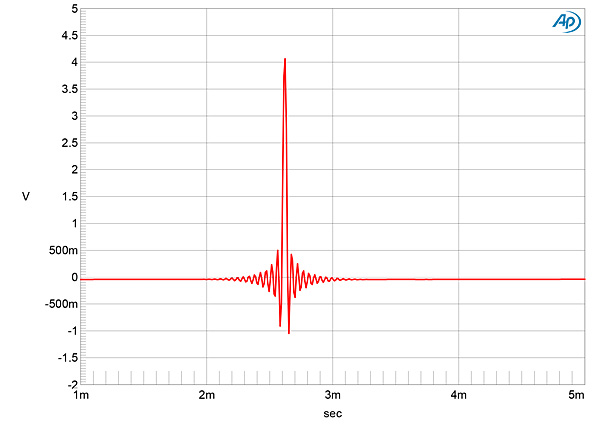
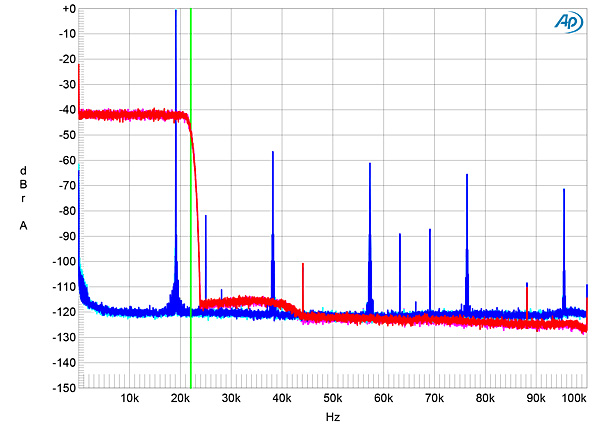
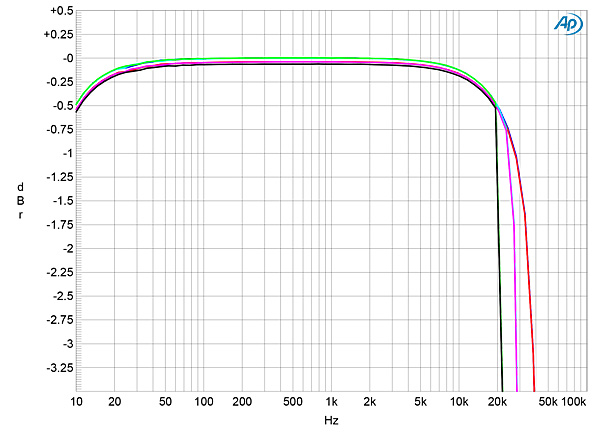
Channel separation for the digital inputs was better at lower frequencies than that of the analog inputs. It measured >76dB below 1kHz, though it decreased to 50dB in both directions at the top of the audioband. When I increased the bit depth from 16 to 24 with a dithered 1kHz tone at –90dBFS (fig.13), the noise floor dropped by about 12dB, meaning that the XM5 offers around 18 bits' worth of resolution. However, these spectra reveal a lot of supply-related spuriae. With undithered data representing a tone at exactly –90.31dBFS (fig.14), the three DC voltage levels described by the data were well resolved and the waveform was symmetrical, though some HF noise was present. With undithered 24-bit data, the result was a slightly noisy sinewave (fig.15).
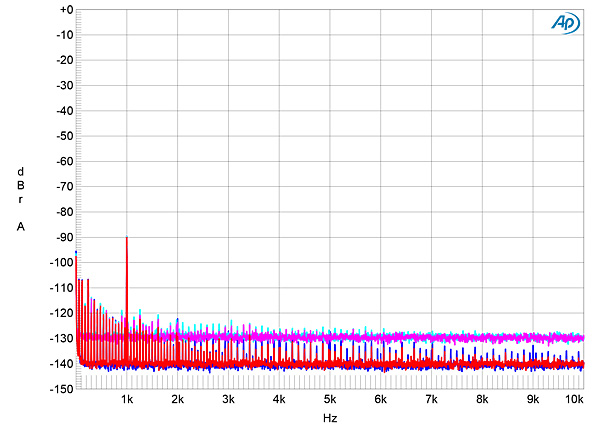
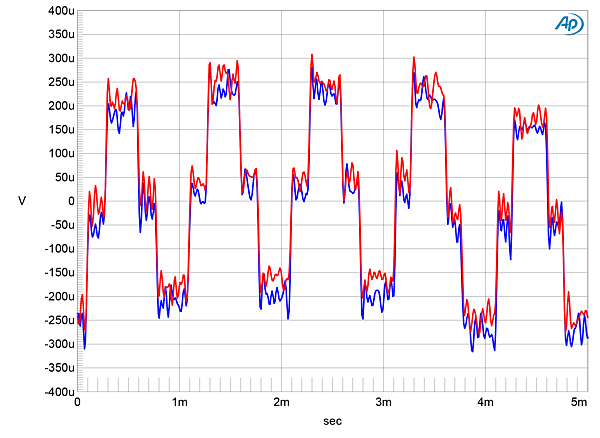
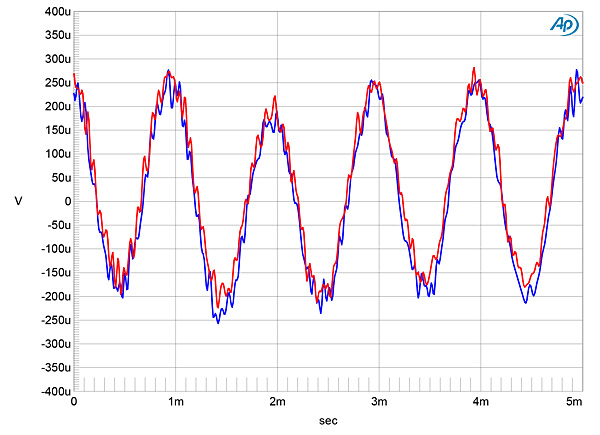
Intermodulation distortion via the XM5's digital inputs was low (fig.16). When I tested the digital inputs' rejection of word-clock jitter with 16-bit J-Test data, the odd-order harmonics of the LSB-level, low-frequency squarewave were all at the correct levels (fig.17, sloping green line). However, many other sidebands are visible, these spaced at 120Hz intervals, which suggests that they might be due to an insufficiently filtered voltage at the DAC chip's reference pin.
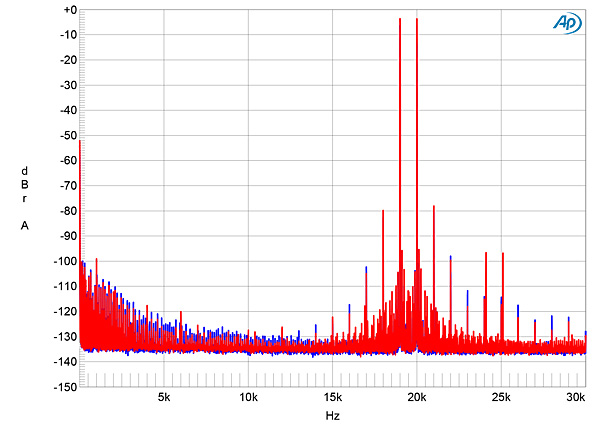
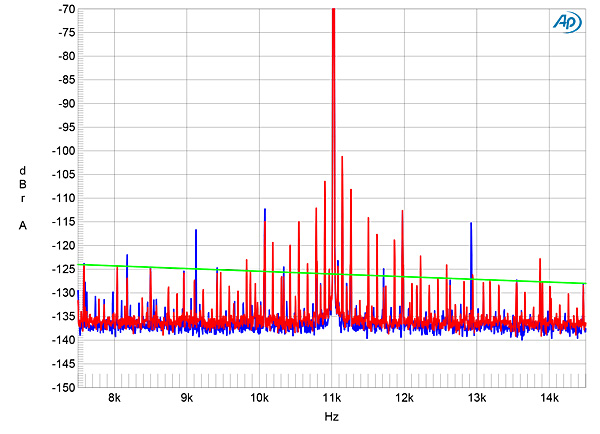
As I was finishing these jitter measurements, the Exposure XM5 overheated and shut down. I had to let it cool down before I could examine the phono input's behavior. For this, I floated the analyzer outputs and ran a separate ground connection from the speaker binding post next to the amplifier's phono input RCAs, which gave the lowest level of noise. With the volume control at its maximum setting, the voltage gain at 1kHz measured 78.8dB from the speaker outputs and 54.9dB from the preamplifier outputs, these gains appropriate for moving-magnet cartridges. Both outputs preserved absolute polarity with phono input signals. The phono input impedance was 47k ohms at low and middle frequencies, dropping slightly to 39k ohms at 20kHz, these impedances also appropriate for MM cartridges.
The phono-stage RIAA error was low in the treble, but featured a 0.7dB plateau in the midrange and a low-frequency rolloff reaching –3dB at 13Hz (fig.18). Fig.18 also reveals a slight (0.2dB) imbalance in favor of the left channel. With the phono inputs shorted to ground and the volume control set to 12 o'clock, the wideband, unweighted signal/noise ratio (ref. a 1kHz input signal at 5mV and measured at the preamp outputs) measured a good 64dB in both channels. An A-weighting filter increased the ratios to 70dB in both channels. Phono-input overload margins were good at lower frequencies, at 15dB at 20Hz and 12dB at 1kHz, but dropped to 9.7dB at 20kHz. Both harmonic distortion (fig.19) and intermodulation distortion (fig.20) were very low in level, even at input levels 6dB higher than usual.
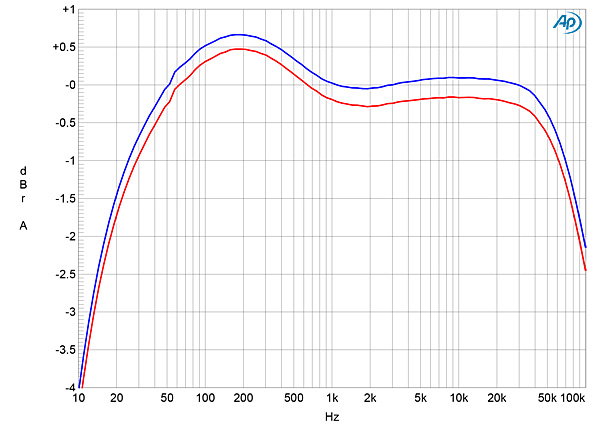
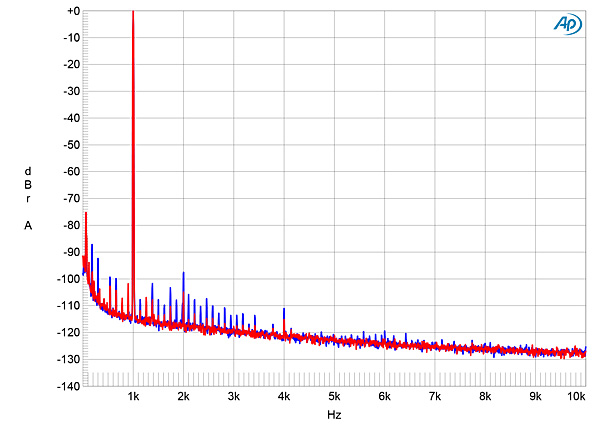
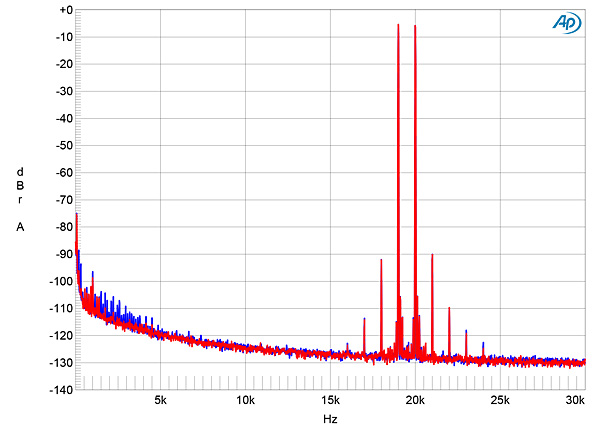
Exposure's XM5 offers generally good measured performance, though I was less impressed by the performance of its digital inputs.—John Atkinson

Denon PMA-1600NE ($1,599) integrated amp would be a good comparison :-) .........

... 60W output rating, one could just as well compare it to the $600 Denon PMA-800NE and/or the $700 Marantz PM7005.

Denon and Marantz units also have tone controls ..... if such things matter :-) .......

Those tone controls are centered at 100Hz and 10KHz ....... Most of the listeners seem to prefer those types of tone controls :-) .........

Yet another component review where the enthusiasm is dependent on the right combination, where a different combination of perfectly good components isn't as good as a different combination.
The differences in the review between being hooked to the Altecs versus the deVores is striking. This little box went from just OK to enjoyable, by switching speakers. That's my greatest sadness about the current trends in audio retailing. There are fewer. Those that exist have stripped their lines down to a few manufacturers. That stripped down inventory definitely has its negatives. I've heard some speakers that I know are fantastic (given the right sources and amps) that sounded dull and flat, because the retailer's limited palette of options didn't match well with them.
Putting a system together, where the components all play well with each other, is now down to guesswork.
My best sounding system is one I got almost 20 years ago... when I could select from and test several different speakers and integrated amps, and then test a few different speaker cabling options. Over the course of a few days, I found a harmonious combination. When the integrated had to go for repair and I had a substitute in the system, suddenly I hated the speakers. When the integrated went up in a spectacular show of flames, I went through a half dozen different units (on 30 day trial, and each time I felt vaguely guilty about the return) to find the one that worked with the system.
I suspect this is a problem limited to the affordable range, and not the very high end.

Yes it seem pretty much to be the audiophile trend to leave tone controls away. The user is forced to a mouse's wheel of buying new speakers, players, amps, speakers, players, amps etc. ad infinitum! Makes sellers and some manufacturers happy...